Yijun Li
VerifyBench: Benchmarking Reference-based Reward Systems for Large Language Models
May 21, 2025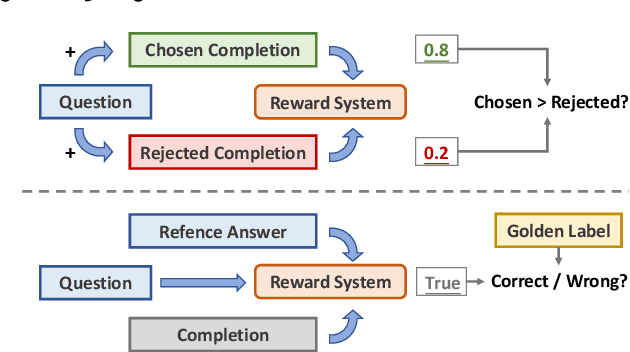
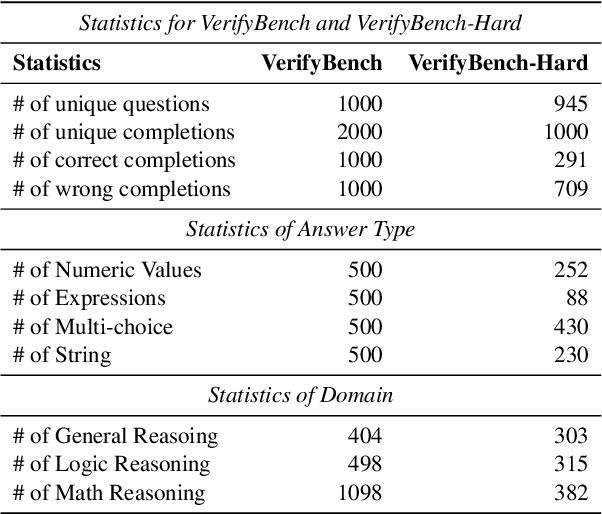
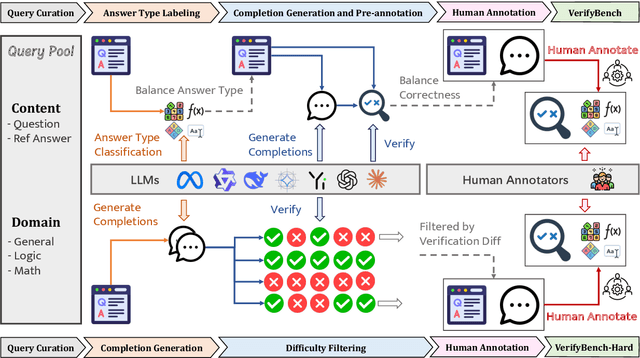
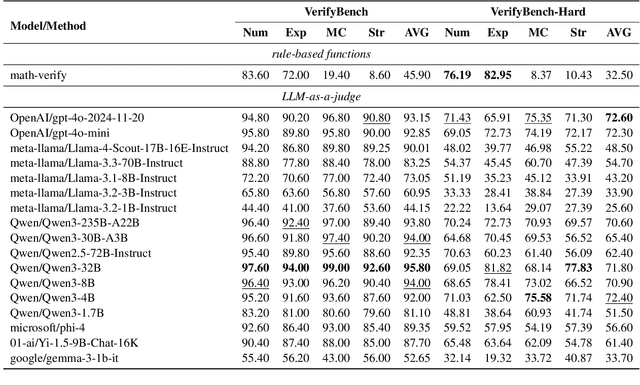
Abstract:Large reasoning models such as OpenAI o1 and DeepSeek-R1 have achieved remarkable performance in the domain of reasoning. A key component of their training is the incorporation of verifiable rewards within reinforcement learning (RL). However, existing reward benchmarks do not evaluate reference-based reward systems, leaving researchers with limited understanding of the accuracy of verifiers used in RL. In this paper, we introduce two benchmarks, VerifyBench and VerifyBench-Hard, designed to assess the performance of reference-based reward systems. These benchmarks are constructed through meticulous data collection and curation, followed by careful human annotation to ensure high quality. Current models still show considerable room for improvement on both VerifyBench and VerifyBench-Hard, especially smaller-scale models. Furthermore, we conduct a thorough and comprehensive analysis of evaluation results, offering insights for understanding and developing reference-based reward systems. Our proposed benchmarks serve as effective tools for guiding the development of verifier accuracy and the reasoning capabilities of models trained via RL in reasoning tasks.
X-Fusion: Introducing New Modality to Frozen Large Language Models
Apr 29, 2025Abstract:We propose X-Fusion, a framework that extends pretrained Large Language Models (LLMs) for multimodal tasks while preserving their language capabilities. X-Fusion employs a dual-tower design with modality-specific weights, keeping the LLM's parameters frozen while integrating vision-specific information for both understanding and generation. Our experiments demonstrate that X-Fusion consistently outperforms alternative architectures on both image-to-text and text-to-image tasks. We find that incorporating understanding-focused data improves generation quality, reducing image data noise enhances overall performance, and feature alignment accelerates convergence for smaller models but has minimal impact on larger ones. Our findings provide valuable insights into building efficient unified multimodal models.
Distributionally Robust Policy Evaluation and Learning for Continuous Treatment with Observational Data
Jan 18, 2025Abstract:Using offline observational data for policy evaluation and learning allows decision-makers to evaluate and learn a policy that connects characteristics and interventions. Most existing literature has focused on either discrete treatment spaces or assumed no difference in the distributions between the policy-learning and policy-deployed environments. These restrict applications in many real-world scenarios where distribution shifts are present with continuous treatment. To overcome these challenges, this paper focuses on developing a distributionally robust policy under a continuous treatment setting. The proposed distributionally robust estimators are established using the Inverse Probability Weighting (IPW) method extended from the discrete one for policy evaluation and learning under continuous treatments. Specifically, we introduce a kernel function into the proposed IPW estimator to mitigate the exclusion of observations that can occur in the standard IPW method to continuous treatments. We then provide finite-sample analysis that guarantees the convergence of the proposed distributionally robust policy evaluation and learning estimators. The comprehensive experiments further verify the effectiveness of our approach when distribution shifts are present.
TransPixar: Advancing Text-to-Video Generation with Transparency
Jan 06, 2025



Abstract:Text-to-video generative models have made significant strides, enabling diverse applications in entertainment, advertising, and education. However, generating RGBA video, which includes alpha channels for transparency, remains a challenge due to limited datasets and the difficulty of adapting existing models. Alpha channels are crucial for visual effects (VFX), allowing transparent elements like smoke and reflections to blend seamlessly into scenes. We introduce TransPixar, a method to extend pretrained video models for RGBA generation while retaining the original RGB capabilities. TransPixar leverages a diffusion transformer (DiT) architecture, incorporating alpha-specific tokens and using LoRA-based fine-tuning to jointly generate RGB and alpha channels with high consistency. By optimizing attention mechanisms, TransPixar preserves the strengths of the original RGB model and achieves strong alignment between RGB and alpha channels despite limited training data. Our approach effectively generates diverse and consistent RGBA videos, advancing the possibilities for VFX and interactive content creation.
Generative Video Propagation
Dec 27, 2024
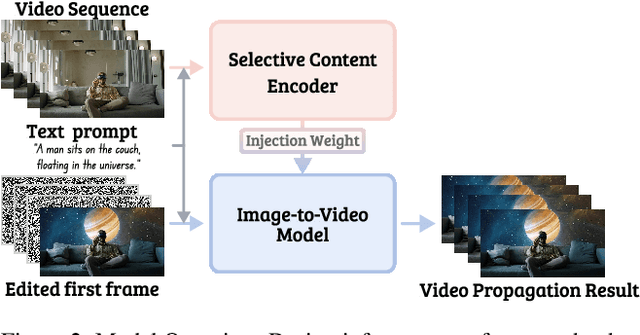

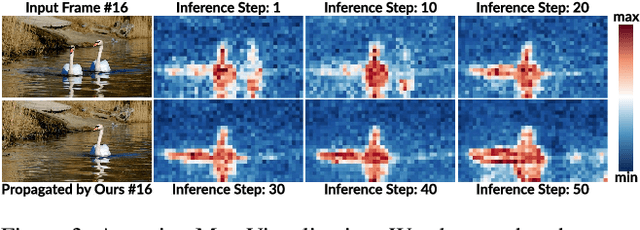
Abstract:Large-scale video generation models have the inherent ability to realistically model natural scenes. In this paper, we demonstrate that through a careful design of a generative video propagation framework, various video tasks can be addressed in a unified way by leveraging the generative power of such models. Specifically, our framework, GenProp, encodes the original video with a selective content encoder and propagates the changes made to the first frame using an image-to-video generation model. We propose a data generation scheme to cover multiple video tasks based on instance-level video segmentation datasets. Our model is trained by incorporating a mask prediction decoder head and optimizing a region-aware loss to aid the encoder to preserve the original content while the generation model propagates the modified region. This novel design opens up new possibilities: In editing scenarios, GenProp allows substantial changes to an object's shape; for insertion, the inserted objects can exhibit independent motion; for removal, GenProp effectively removes effects like shadows and reflections from the whole video; for tracking, GenProp is capable of tracking objects and their associated effects together. Experiment results demonstrate the leading performance of our model in various video tasks, and we further provide in-depth analyses of the proposed framework.
UniReal: Universal Image Generation and Editing via Learning Real-world Dynamics
Dec 10, 2024



Abstract:We introduce UniReal, a unified framework designed to address various image generation and editing tasks. Existing solutions often vary by tasks, yet share fundamental principles: preserving consistency between inputs and outputs while capturing visual variations. Inspired by recent video generation models that effectively balance consistency and variation across frames, we propose a unifying approach that treats image-level tasks as discontinuous video generation. Specifically, we treat varying numbers of input and output images as frames, enabling seamless support for tasks such as image generation, editing, customization, composition, etc. Although designed for image-level tasks, we leverage videos as a scalable source for universal supervision. UniReal learns world dynamics from large-scale videos, demonstrating advanced capability in handling shadows, reflections, pose variation, and object interaction, while also exhibiting emergent capability for novel applications.
LayerFusion: Harmonized Multi-Layer Text-to-Image Generation with Generative Priors
Dec 05, 2024
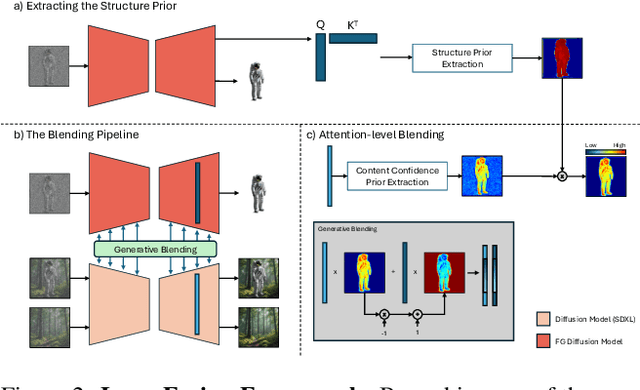

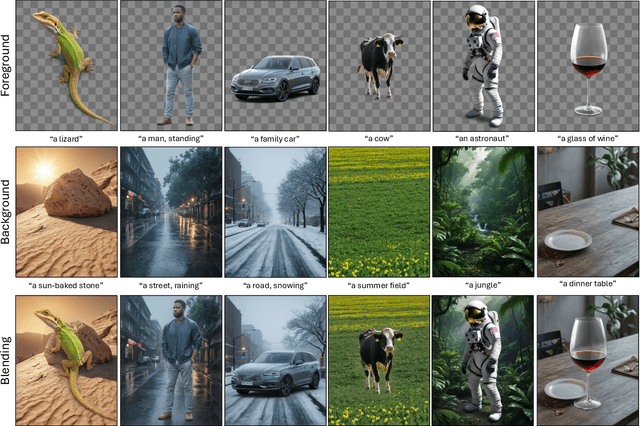
Abstract:Large-scale diffusion models have achieved remarkable success in generating high-quality images from textual descriptions, gaining popularity across various applications. However, the generation of layered content, such as transparent images with foreground and background layers, remains an under-explored area. Layered content generation is crucial for creative workflows in fields like graphic design, animation, and digital art, where layer-based approaches are fundamental for flexible editing and composition. In this paper, we propose a novel image generation pipeline based on Latent Diffusion Models (LDMs) that generates images with two layers: a foreground layer (RGBA) with transparency information and a background layer (RGB). Unlike existing methods that generate these layers sequentially, our approach introduces a harmonized generation mechanism that enables dynamic interactions between the layers for more coherent outputs. We demonstrate the effectiveness of our method through extensive qualitative and quantitative experiments, showing significant improvements in visual coherence, image quality, and layer consistency compared to baseline methods.
Generative Image Layer Decomposition with Visual Effects
Nov 26, 2024



Abstract:Recent advancements in large generative models, particularly diffusion-based methods, have significantly enhanced the capabilities of image editing. However, achieving precise control over image composition tasks remains a challenge. Layered representations, which allow for independent editing of image components, are essential for user-driven content creation, yet existing approaches often struggle to decompose image into plausible layers with accurately retained transparent visual effects such as shadows and reflections. We propose $\textbf{LayerDecomp}$, a generative framework for image layer decomposition which outputs photorealistic clean backgrounds and high-quality transparent foregrounds with faithfully preserved visual effects. To enable effective training, we first introduce a dataset preparation pipeline that automatically scales up simulated multi-layer data with synthesized visual effects. To further enhance real-world applicability, we supplement this simulated dataset with camera-captured images containing natural visual effects. Additionally, we propose a consistency loss which enforces the model to learn accurate representations for the transparent foreground layer when ground-truth annotations are not available. Our method achieves superior quality in layer decomposition, outperforming existing approaches in object removal and spatial editing tasks across several benchmarks and multiple user studies, unlocking various creative possibilities for layer-wise image editing. The project page is https://rayjryang.github.io/LayerDecomp.
A Hybrid Defense Strategy for Boosting Adversarial Robustness in Vision-Language Models
Oct 18, 2024Abstract:The robustness of Vision-Language Models (VLMs) such as CLIP is critical for their deployment in safety-critical applications like autonomous driving, healthcare diagnostics, and security systems, where accurate interpretation of visual and textual data is essential. However, these models are highly susceptible to adversarial attacks, which can severely compromise their performance and reliability in real-world scenarios. Previous methods have primarily focused on improving robustness through adversarial training and generating adversarial examples using models like FGSM, AutoAttack, and DeepFool. However, these approaches often rely on strong assumptions, such as fixed perturbation norms or predefined attack patterns, and involve high computational complexity, making them challenging to implement in practical settings. In this paper, we propose a novel adversarial training framework that integrates multiple attack strategies and advanced machine learning techniques to significantly enhance the robustness of VLMs against a broad range of adversarial attacks. Experiments conducted on real-world datasets, including CIFAR-10 and CIFAR-100, demonstrate that the proposed method significantly enhances model robustness. The fine-tuned CLIP model achieved an accuracy of 43.5% on adversarially perturbed images, compared to only 4% for the baseline model. The neural network model achieved a high accuracy of 98% in these challenging classification tasks, while the XGBoost model reached a success rate of 85.26% in prediction tasks.
Removing Distributional Discrepancies in Captions Improves Image-Text Alignment
Oct 01, 2024



Abstract:In this paper, we introduce a model designed to improve the prediction of image-text alignment, targeting the challenge of compositional understanding in current visual-language models. Our approach focuses on generating high-quality training datasets for the alignment task by producing mixed-type negative captions derived from positive ones. Critically, we address the distribution imbalance between positive and negative captions to ensure that the alignment model does not depend solely on textual information but also considers the associated images for predicting alignment accurately. By creating this enhanced training data, we fine-tune an existing leading visual-language model to boost its capability in understanding alignment. Our model significantly outperforms current top-performing methods across various datasets. We also demonstrate the applicability of our model by ranking the images generated by text-to-image models based on text alignment. Project page: \url{https://yuheng-li.github.io/LLaVA-score/}
 Add to Chrome
Add to Chrome Add to Firefox
Add to Firefox Add to Edge
Add to Edge